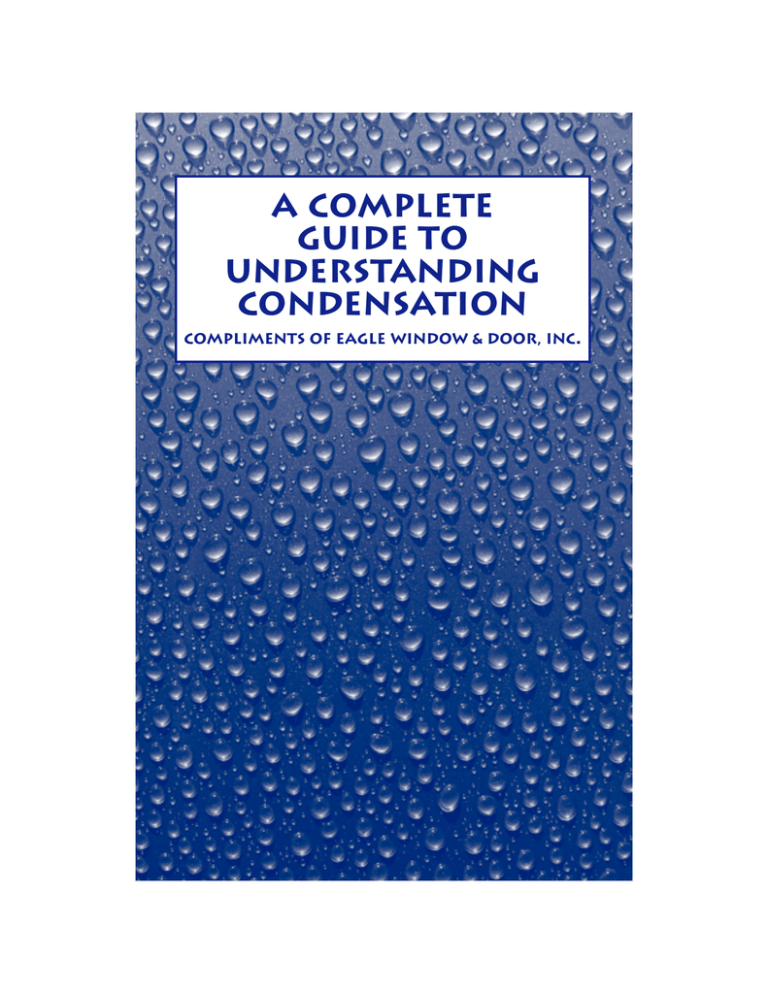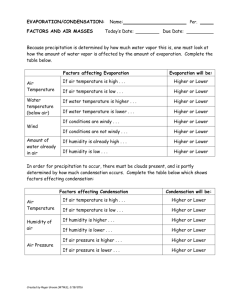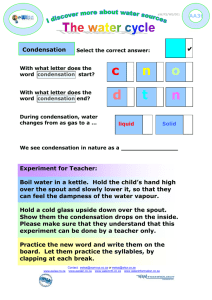A COMPLETE gUIDE TO UNDERSTANDINg CONDENSATION
advertisement

A complete guide to understanding condensation Compliments of Eagle Window & Door, Inc. What is condensation? Condensation is the visible result of excess humidity. Warm air holds more moisture than cool air; but when warm air meets a cool surface, it cools and can’t hold as much moisture. This excess moisture changes to water and becomes visible as condensation. Condensation is produced by moisture in the air; it is not produced by the window. What causes it? Moist air is always trying to reach dry air. This is called vapor pressure and it cannot be stopped by porous building materials, such as wood, plaster, stone or brick. It is stopped, however, by certain paints, plastic, and glass. This is why you see condensation on your windows first and why it should alert you to the fact that condensation could be occurring where you cannot see it – within your walls. Where does excess humidity come from? To avoid moisture collection problems, it is important to understand how your home collects excess humidity. According to Consumer Reports (September, 1989), “A house – one with preventative measures – full insulation, a vapor barrier, snugly fitted and weather-stripped windows and doors, and a dampered fireplace needs less humidification than a house without preventative measures.” That’s because when you seal out the cold, you seal in the humidity, and continue to add to it daily. Consider the amount of water vapor an average family of four generates in ordinary daily activities. (Moisture produced by the average family of four expressed in pounds per day.) Breathing and perspiring Washing clothes Drying clothes (unvented) Washing floors Cooking Washing dishes Showering Houseplants Humidifiers 16 4 26 2 2 2 2 1 1 It could total as little as 20 lbs (2 gallons), or as much as 50 lbs (5 gallons) in a single day. Now consider that it only takes 4-6 pints of water to raise the humidity level of a 1000 square-foot house from 15 to 60 percent. Household humidity is even higher when a house is on a poorly graded lot, has a concrete slab floor at or below grade or has uncovered ground in the crawl space. How can this harm your home? The moist inside air, trying to reach the dry outside air, flows through your walls, is trapped by the exterior paint and is likely to freeze there. When it thaws in the spring it can ruin the plaster, rot the wood frame or cause the exterior paint to blister or peel. Not all condensation is serious Fortunately, not all window condensation represents major problems. If warm air circulation is impeded by drapes, shades or the shape of the window (bay or bow windows for example), then condensation can occur. In the case of the bay or bow window, a small fan will usually direct enough warm air into the space to keep the windows clear. They should of course have adequate insulation around the frame. Temporary Condensation Other conditions are merely temporary. If condensation occurs in only the first weeks of heating, your house may be simply drying off after an especially humid summer. Because of moisture in building materials, new homes and remodeled homes need a temporary drying off period. Humidifier Fever Many people feel the need to add moisture to their air with a humidifier. But in fact, besides contributing to your condensation problems, humidifiers can cause respiratory problems. U.S. ENVIRONMENTAL PROTECTION AGENCY SCIENTISTS are concerned by the raised concentration of inhalable particles in the air when humidifiers are used. The quality of the air, they say, is directly related to the quality of the water used. When used with tap water, which could carry lead, aluminum and asbestos, the air quality could be reduced to dangerous levels. And, according to CONSUMER REPORTS, “Unless they’re kept unscrupulously clean, humidifiers can encourage the growth of molds and bacteria in reservoirs and over-humidified rooms.” These molds and bacteria can cause an allergic reaction in usually healthy people and can be especially dangerous to infants, the elderly, and people with impaired immune systems. An American Lung Association brochure (Hypersensitivity Pneumonitus, June 1983) states the Humidifier Lung causes flu-like symptoms 4-6 hours after exposure, and after repeated exposure these symptoms and more become chronic and eventually lead to permanent lung damage. Ventilation Since the early ‘70’s and the awareness of the energy crisis, people have insisted on tighter homes to conserve resources and dollars. This has caused a reaction people did not count on: the pressure plane level within houses was reversed. Before, dry cold air was drawn in through every crack and opening. Now, warm moist air is drawn out. In reaction to this, people have sealed their homes even tighter causing 1) less natural ventilation and 2) more excess humidity. Ventilation provided the key to comfortable condensation-free homes. There are three basic ventilation systems. The first (shown in House A) is a system of exhaust fans and inlet openings which cause the pressure inside the house to be lower than outside. The fresh dry air is drawn in through adjustable vents placed near the windows, while the stale humid air is exhausted from a single point by a fan. The second (House B) is called a balance system because the pressure inside the house is approximately the same as outside. This is achieved by drawing the fresh air in by a supply fan, where it is heated or conditioned and distributed and then exhausted by another fan. Third is the pressurized system (House C) where the pressure inside the house is higher than that outside. In this case, air is brought in by a supply fan and allowed to exhaust through cracks and openings. This could increase the concealed condensation rate, but it is the choice of experts when gases or contaminants exist in the house walls. In each case, stale humid air is being exhausted, but so is the expensive heat. Heat recovery systems, such as heat pumps and air-to-air exchangers, are helpful here (Houses D & E). However, since these systems rely on all the exhaust air passing through a single point, they can only work with an exhaust system or a balanced system, not a pressurized system. Some air-to-air heat exchangers also exchange moisture. Still, if you have a tightly insulated house, ventilated like Houses A or B, and you want to use less fuel, a heat recovery system could be your answer. What can you do to reduce excess humidity? Now that you know the causes of excess household humidity, some of the solutions are quite simple: 1) 2) 3) 4) 5) 6) 7) 8) 9) 10) 11) 12) 13) 14) Kitchens, baths and laundry rooms should have fans that exhaust to the exterior. Make sure you use them! Vent your clothes dryer to the outside: don’t hang wet clothes inside to dry. Run full loads of clothes and dishes in the washers to reduce the number of uses. Take shorter baths and showers. Cover pots and pans when cooking. Fix dripping faucets and cover sweating cold water pipes, and heat ducts with insulation blankets. Crawl spaces should be ventilated and covered with a vapor barrier. In an old house, either install a vapor barrier, or more simply use a vapor barrier paint or vapor barrier primer under regular paint. In a weathertight house install an air-to-air heat exchanger – it replaces humid room air with dry outside air with a minimum of energy usage. Don’t store firewood inside. Vent office spaces. Make sure your humidifier is working correctly. Turn it down as the weather becomes colder. If you have a forced air furnace, make sure your home is properly ventilated by installing a fresh air intake. As a temporary solution, you may want to try opening your windows a little each day to allow the exchange of colder, drier air with warmer, more humid air. This should not effect your energy bill in any substantial manner. To reduce condensation you must control humidity In addition to reducing humidity throughout your home, here are some suggestions to help control condensation on your windows: 1) Circulate the air to maintain an even temperature. 2) Use a dehumidifier in the basement and other rooms where the humidity is high. 3) A good way to stop condensation is to install storm windows or replace single-glazed windows with double or triple-glazed windows. 4) If your humidity level is high relative to the outside and inside temperature, condensation will still occur, regardless of what windows you have. Ideal Levels of Relative Humidity So what is the ideal amount of relative humidity in the air? Based on keeping an indoor temperature of 70º F, it will vary with the outdoor temperature. But as a guide, the following relationship should help. Outside Air Temp. -20ºF or cooler -20ºF -10ºF 0ºF 10ºF 20ºF Inside Relative Humidity 15% 20% 25% 30% 35% 40% Maximum Maximum Maximum Maximum Maximum Maximum If your relative humidity is above these levels, you probably will have condensation on cool surfaces. Testing your home’s humidity You can test your home’s humidity with a sling psychrometer. Just remember that at lower temperatures, lower humidities are recommended. An example is that at 10º F, humidity should not exceed 35%. Your heating specialist or your architect should be able to help you determine the level of humidity in your home. energy efficient windows and doors and why they will help Windows and doors have become an important part of your energy saving plan. They prevent cold air from entering around them, thus cooling the surface. Spacers between glazing in today’s double or triple-glazed windows are used for energy efficiency because they prevent cold air from migrating through them, causing the glass to cool. Special metallic coatings have been developed (known as Low-E or emmissivity) which reflect radiant heat and restrict its flow through glass. In cold weather, it keeps heat inside. In hot weather, it keeps heat outside. Using these energy efficient windows will keep the interior glass surfaces warmer, reducing the interior cool surfaces where moisture can condensate. However, they do not block the existence of condensation and they do not cause it. Remember, if you have water, frost or ice on the surface of your double-glazed windows, you have excess humidity. To reduce condensation, you must reduce humidity. If you still have trouble with condensation after following the suggestions outlined here, please see your architect or heating specialist. Sources: Merrill, John L., Moisture Problems In the Home, Indoor Air Quality, North Central Regional Extension Publication 312. Augustine, Marla, Dirty Humidifiers May Cause Health Problems, HealthBeat, Nebraska Department Of Health. Krahn, Jim, Factors In Condensation On Glass, Minnesota Energy Council 1989 Congress and Exhibition, February 1989. Jones, Rudyard A., Council Notes, Moisture Condensation, Volume 1, Number 1, 1975, University of Illinois at Urbana-Champaign Small Homes Council-Building Research Council. American Lung Association, Lung Hazards on the Job: Hypersensitivity Pneumonitus, June 1983. Humidifiers, Consumer Reports, 53:328-35, December 1988. Harrison’s Principle’s of Internal Medicine, 11th Edition, McGraw Hill Book Company, 1987, pp 1065-1067. Asthma & Allergy Foundation of America, Mold Allergy, October, 1983. National Wood Window and Door Association - Understanding Condensation, 1997. Distributed by: ® Eagle Window & Door, Inc. P.O. Box 1072, 2045 Kerper Blvd. Dubuque, IA 52004-1072 (563) 556-2270 FAX: (563) 556-3825 www.eaglewindow.com © 2002 EAGLE Window & Door, Inc. Part #: CONDENSATION Rev. 12/01





